Health Literacy and Effective Communication in Healthcare
VerifiedAdded on 2023/06/14
|12
|2756
|324
Essay
AI Summary
This essay explores the critical concepts of health literacy and effective communication within the healthcare sector, emphasizing their significance in fostering culturally safe practices. It defines health literacy according to the Affordable Care Act of 2010 and highlights effective communication as a vital tool for high-quality patient care. The essay delves into the importance of health literacy and communication in promoting patient-centered care, consumer participation, cultural responsiveness, and ensuring quality and safety in healthcare delivery. It also addresses the need for culturally effective communication, suggesting tactics for medical professionals to improve interactions with patients from diverse backgrounds. Furthermore, the role of interpreters in bridging cultural and linguistic gaps is examined, along with the relationship between health literacy and communication. The essay concludes by emphasizing the need for strategies to address health literacy at organizational and systemic levels, advocating for the integration of health literacy into educational programs for both consumers and professionals, and highlighting the importance of continuous improvement in health literacy for better patient outcomes and quality of life. Desklib offers a range of resources for students seeking to enhance their understanding of these vital healthcare concepts.
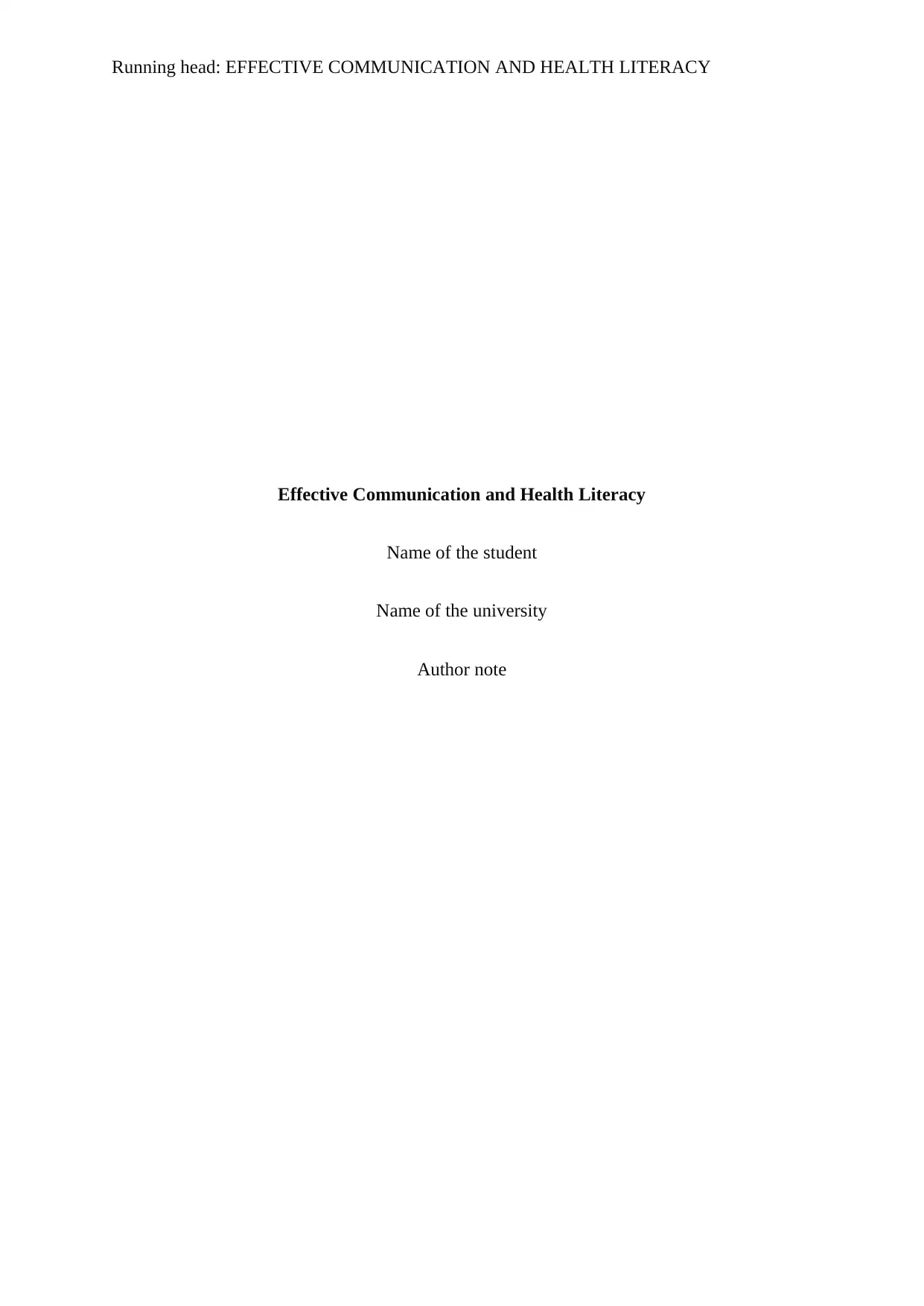
Running head: EFFECTIVE COMMUNICATION AND HEALTH LITERACY
Effective Communication and Health Literacy
Name of the student
Name of the university
Author note
Effective Communication and Health Literacy
Name of the student
Name of the university
Author note
Paraphrase This Document
Need a fresh take? Get an instant paraphrase of this document with our AI Paraphraser
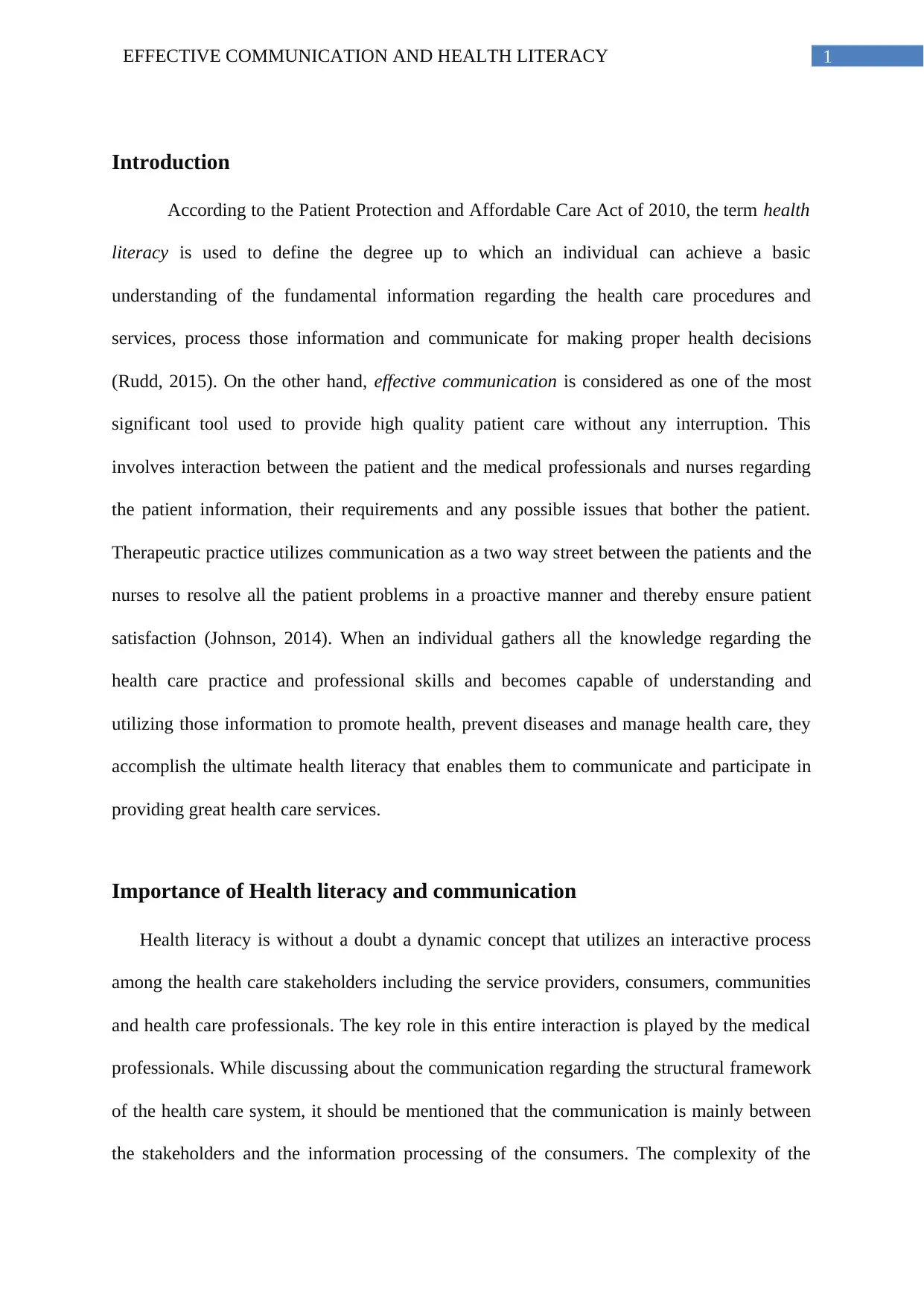
1EFFECTIVE COMMUNICATION AND HEALTH LITERACY
Introduction
According to the Patient Protection and Affordable Care Act of 2010, the term health
literacy is used to define the degree up to which an individual can achieve a basic
understanding of the fundamental information regarding the health care procedures and
services, process those information and communicate for making proper health decisions
(Rudd, 2015). On the other hand, effective communication is considered as one of the most
significant tool used to provide high quality patient care without any interruption. This
involves interaction between the patient and the medical professionals and nurses regarding
the patient information, their requirements and any possible issues that bother the patient.
Therapeutic practice utilizes communication as a two way street between the patients and the
nurses to resolve all the patient problems in a proactive manner and thereby ensure patient
satisfaction (Johnson, 2014). When an individual gathers all the knowledge regarding the
health care practice and professional skills and becomes capable of understanding and
utilizing those information to promote health, prevent diseases and manage health care, they
accomplish the ultimate health literacy that enables them to communicate and participate in
providing great health care services.
Importance of Health literacy and communication
Health literacy is without a doubt a dynamic concept that utilizes an interactive process
among the health care stakeholders including the service providers, consumers, communities
and health care professionals. The key role in this entire interaction is played by the medical
professionals. While discussing about the communication regarding the structural framework
of the health care system, it should be mentioned that the communication is mainly between
the stakeholders and the information processing of the consumers. The complexity of the
Introduction
According to the Patient Protection and Affordable Care Act of 2010, the term health
literacy is used to define the degree up to which an individual can achieve a basic
understanding of the fundamental information regarding the health care procedures and
services, process those information and communicate for making proper health decisions
(Rudd, 2015). On the other hand, effective communication is considered as one of the most
significant tool used to provide high quality patient care without any interruption. This
involves interaction between the patient and the medical professionals and nurses regarding
the patient information, their requirements and any possible issues that bother the patient.
Therapeutic practice utilizes communication as a two way street between the patients and the
nurses to resolve all the patient problems in a proactive manner and thereby ensure patient
satisfaction (Johnson, 2014). When an individual gathers all the knowledge regarding the
health care practice and professional skills and becomes capable of understanding and
utilizing those information to promote health, prevent diseases and manage health care, they
accomplish the ultimate health literacy that enables them to communicate and participate in
providing great health care services.
Importance of Health literacy and communication
Health literacy is without a doubt a dynamic concept that utilizes an interactive process
among the health care stakeholders including the service providers, consumers, communities
and health care professionals. The key role in this entire interaction is played by the medical
professionals. While discussing about the communication regarding the structural framework
of the health care system, it should be mentioned that the communication is mainly between
the stakeholders and the information processing of the consumers. The complexity of the
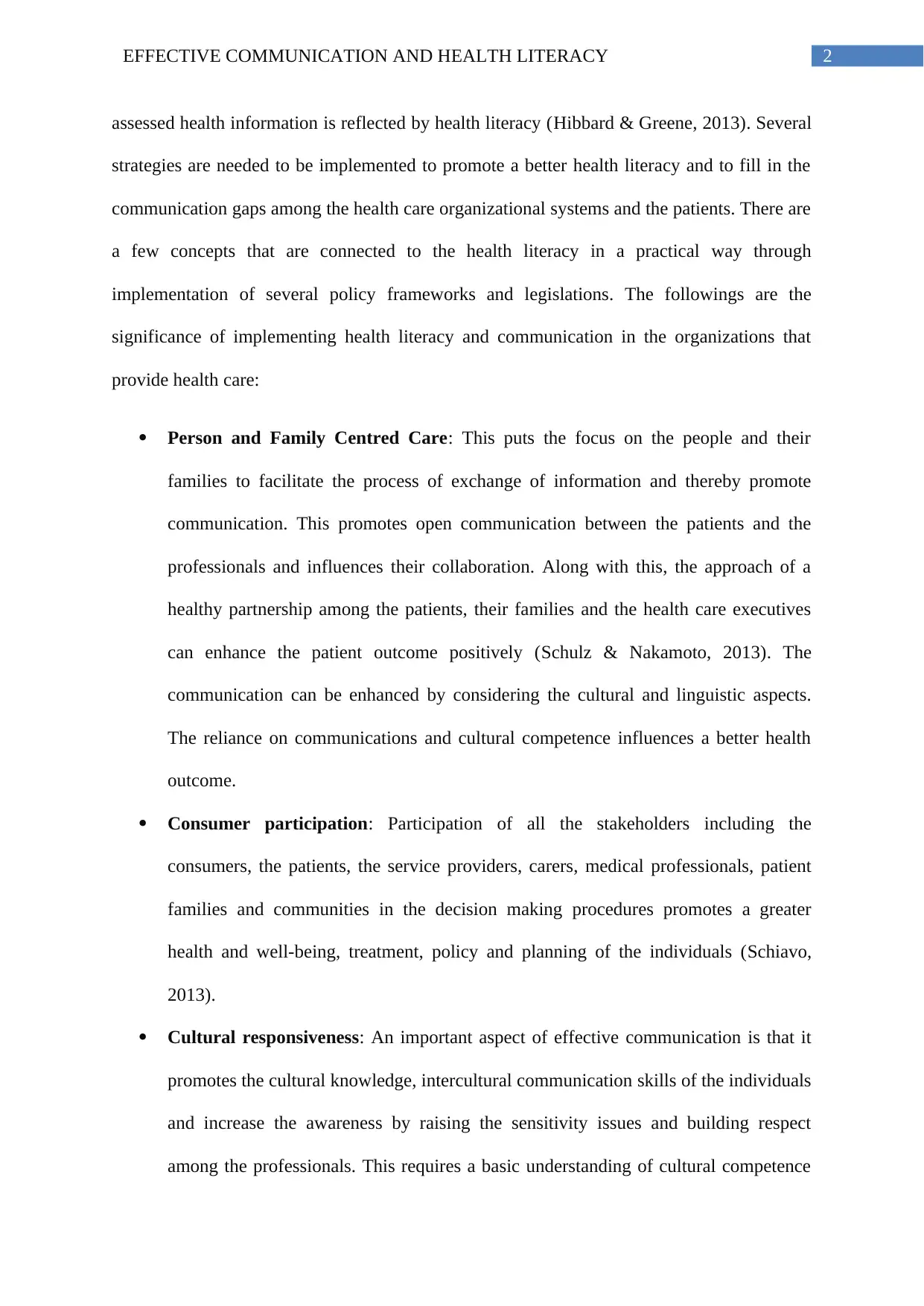
2EFFECTIVE COMMUNICATION AND HEALTH LITERACY
assessed health information is reflected by health literacy (Hibbard & Greene, 2013). Several
strategies are needed to be implemented to promote a better health literacy and to fill in the
communication gaps among the health care organizational systems and the patients. There are
a few concepts that are connected to the health literacy in a practical way through
implementation of several policy frameworks and legislations. The followings are the
significance of implementing health literacy and communication in the organizations that
provide health care:
Person and Family Centred Care: This puts the focus on the people and their
families to facilitate the process of exchange of information and thereby promote
communication. This promotes open communication between the patients and the
professionals and influences their collaboration. Along with this, the approach of a
healthy partnership among the patients, their families and the health care executives
can enhance the patient outcome positively (Schulz & Nakamoto, 2013). The
communication can be enhanced by considering the cultural and linguistic aspects.
The reliance on communications and cultural competence influences a better health
outcome.
Consumer participation: Participation of all the stakeholders including the
consumers, the patients, the service providers, carers, medical professionals, patient
families and communities in the decision making procedures promotes a greater
health and well-being, treatment, policy and planning of the individuals (Schiavo,
2013).
Cultural responsiveness: An important aspect of effective communication is that it
promotes the cultural knowledge, intercultural communication skills of the individuals
and increase the awareness by raising the sensitivity issues and building respect
among the professionals. This requires a basic understanding of cultural competence
assessed health information is reflected by health literacy (Hibbard & Greene, 2013). Several
strategies are needed to be implemented to promote a better health literacy and to fill in the
communication gaps among the health care organizational systems and the patients. There are
a few concepts that are connected to the health literacy in a practical way through
implementation of several policy frameworks and legislations. The followings are the
significance of implementing health literacy and communication in the organizations that
provide health care:
Person and Family Centred Care: This puts the focus on the people and their
families to facilitate the process of exchange of information and thereby promote
communication. This promotes open communication between the patients and the
professionals and influences their collaboration. Along with this, the approach of a
healthy partnership among the patients, their families and the health care executives
can enhance the patient outcome positively (Schulz & Nakamoto, 2013). The
communication can be enhanced by considering the cultural and linguistic aspects.
The reliance on communications and cultural competence influences a better health
outcome.
Consumer participation: Participation of all the stakeholders including the
consumers, the patients, the service providers, carers, medical professionals, patient
families and communities in the decision making procedures promotes a greater
health and well-being, treatment, policy and planning of the individuals (Schiavo,
2013).
Cultural responsiveness: An important aspect of effective communication is that it
promotes the cultural knowledge, intercultural communication skills of the individuals
and increase the awareness by raising the sensitivity issues and building respect
among the professionals. This requires a basic understanding of cultural competence
⊘ This is a preview!⊘
Do you want full access?
Subscribe today to unlock all pages.

Trusted by 1+ million students worldwide
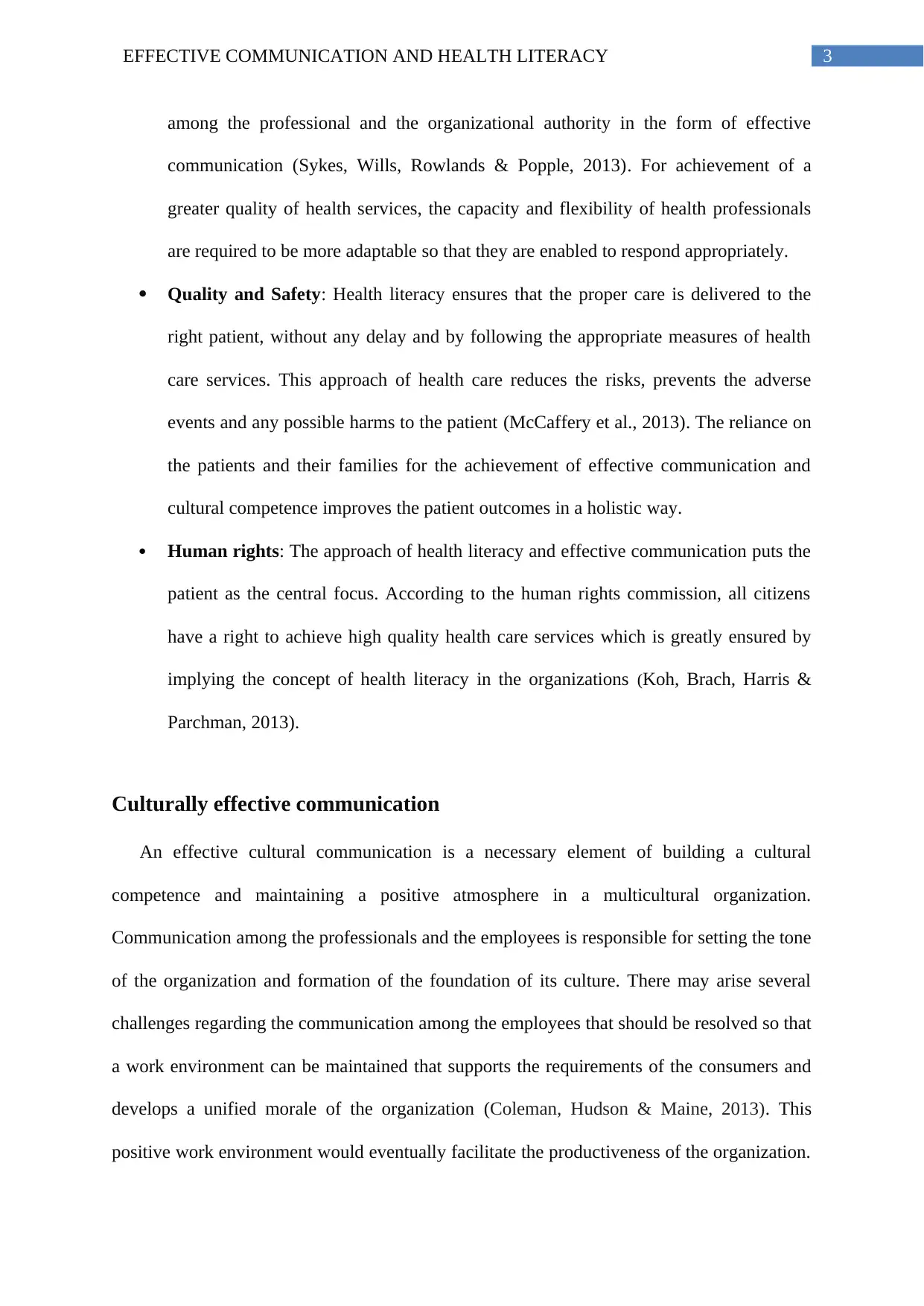
3EFFECTIVE COMMUNICATION AND HEALTH LITERACY
among the professional and the organizational authority in the form of effective
communication (Sykes, Wills, Rowlands & Popple, 2013). For achievement of a
greater quality of health services, the capacity and flexibility of health professionals
are required to be more adaptable so that they are enabled to respond appropriately.
Quality and Safety: Health literacy ensures that the proper care is delivered to the
right patient, without any delay and by following the appropriate measures of health
care services. This approach of health care reduces the risks, prevents the adverse
events and any possible harms to the patient (McCaffery et al., 2013). The reliance on
the patients and their families for the achievement of effective communication and
cultural competence improves the patient outcomes in a holistic way.
Human rights: The approach of health literacy and effective communication puts the
patient as the central focus. According to the human rights commission, all citizens
have a right to achieve high quality health care services which is greatly ensured by
implying the concept of health literacy in the organizations (Koh, Brach, Harris &
Parchman, 2013).
Culturally effective communication
An effective cultural communication is a necessary element of building a cultural
competence and maintaining a positive atmosphere in a multicultural organization.
Communication among the professionals and the employees is responsible for setting the tone
of the organization and formation of the foundation of its culture. There may arise several
challenges regarding the communication among the employees that should be resolved so that
a work environment can be maintained that supports the requirements of the consumers and
develops a unified morale of the organization (Coleman, Hudson & Maine, 2013). This
positive work environment would eventually facilitate the productiveness of the organization.
among the professional and the organizational authority in the form of effective
communication (Sykes, Wills, Rowlands & Popple, 2013). For achievement of a
greater quality of health services, the capacity and flexibility of health professionals
are required to be more adaptable so that they are enabled to respond appropriately.
Quality and Safety: Health literacy ensures that the proper care is delivered to the
right patient, without any delay and by following the appropriate measures of health
care services. This approach of health care reduces the risks, prevents the adverse
events and any possible harms to the patient (McCaffery et al., 2013). The reliance on
the patients and their families for the achievement of effective communication and
cultural competence improves the patient outcomes in a holistic way.
Human rights: The approach of health literacy and effective communication puts the
patient as the central focus. According to the human rights commission, all citizens
have a right to achieve high quality health care services which is greatly ensured by
implying the concept of health literacy in the organizations (Koh, Brach, Harris &
Parchman, 2013).
Culturally effective communication
An effective cultural communication is a necessary element of building a cultural
competence and maintaining a positive atmosphere in a multicultural organization.
Communication among the professionals and the employees is responsible for setting the tone
of the organization and formation of the foundation of its culture. There may arise several
challenges regarding the communication among the employees that should be resolved so that
a work environment can be maintained that supports the requirements of the consumers and
develops a unified morale of the organization (Coleman, Hudson & Maine, 2013). This
positive work environment would eventually facilitate the productiveness of the organization.
Paraphrase This Document
Need a fresh take? Get an instant paraphrase of this document with our AI Paraphraser
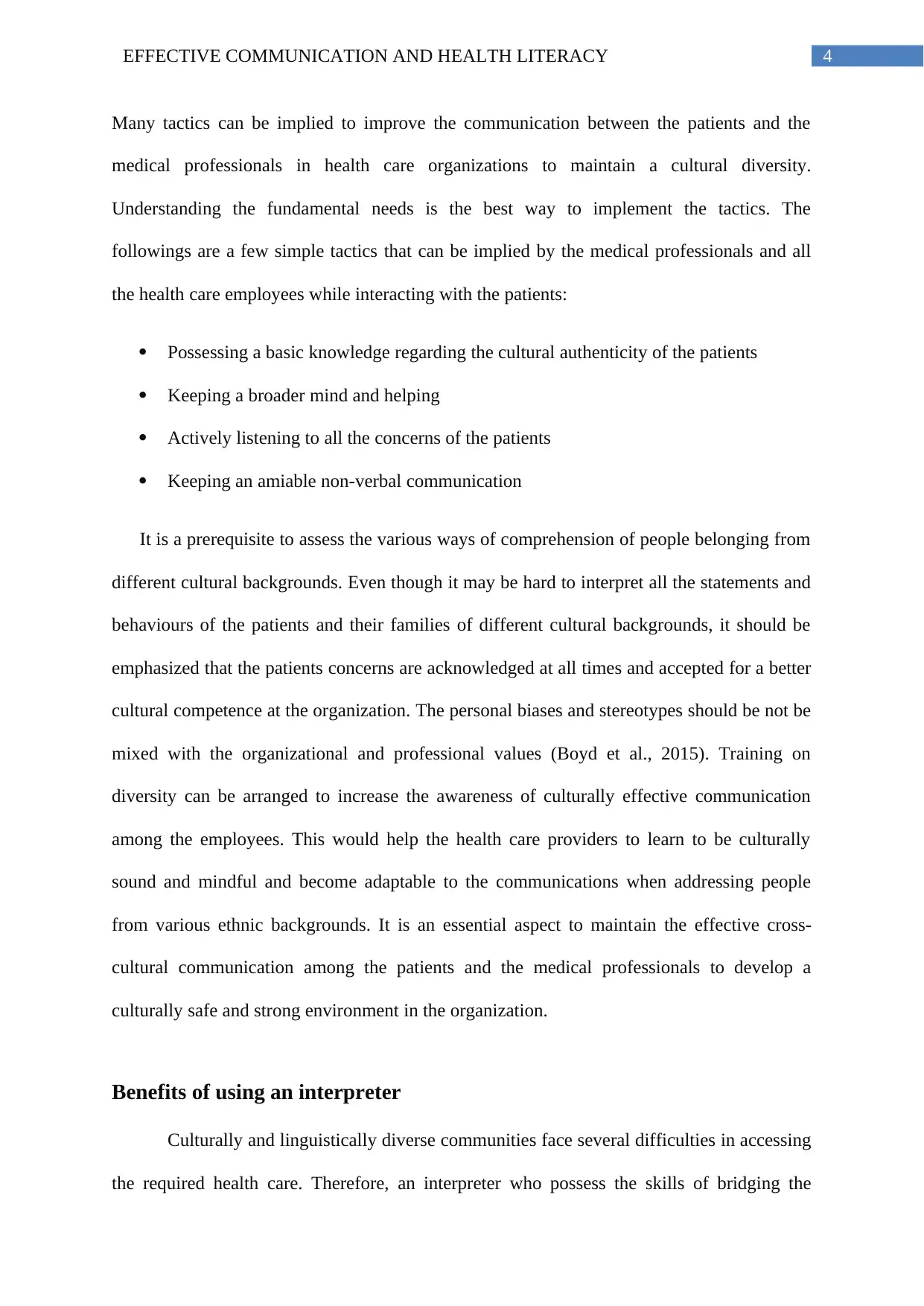
4EFFECTIVE COMMUNICATION AND HEALTH LITERACY
Many tactics can be implied to improve the communication between the patients and the
medical professionals in health care organizations to maintain a cultural diversity.
Understanding the fundamental needs is the best way to implement the tactics. The
followings are a few simple tactics that can be implied by the medical professionals and all
the health care employees while interacting with the patients:
Possessing a basic knowledge regarding the cultural authenticity of the patients
Keeping a broader mind and helping
Actively listening to all the concerns of the patients
Keeping an amiable non-verbal communication
It is a prerequisite to assess the various ways of comprehension of people belonging from
different cultural backgrounds. Even though it may be hard to interpret all the statements and
behaviours of the patients and their families of different cultural backgrounds, it should be
emphasized that the patients concerns are acknowledged at all times and accepted for a better
cultural competence at the organization. The personal biases and stereotypes should be not be
mixed with the organizational and professional values (Boyd et al., 2015). Training on
diversity can be arranged to increase the awareness of culturally effective communication
among the employees. This would help the health care providers to learn to be culturally
sound and mindful and become adaptable to the communications when addressing people
from various ethnic backgrounds. It is an essential aspect to maintain the effective cross-
cultural communication among the patients and the medical professionals to develop a
culturally safe and strong environment in the organization.
Benefits of using an interpreter
Culturally and linguistically diverse communities face several difficulties in accessing
the required health care. Therefore, an interpreter who possess the skills of bridging the
Many tactics can be implied to improve the communication between the patients and the
medical professionals in health care organizations to maintain a cultural diversity.
Understanding the fundamental needs is the best way to implement the tactics. The
followings are a few simple tactics that can be implied by the medical professionals and all
the health care employees while interacting with the patients:
Possessing a basic knowledge regarding the cultural authenticity of the patients
Keeping a broader mind and helping
Actively listening to all the concerns of the patients
Keeping an amiable non-verbal communication
It is a prerequisite to assess the various ways of comprehension of people belonging from
different cultural backgrounds. Even though it may be hard to interpret all the statements and
behaviours of the patients and their families of different cultural backgrounds, it should be
emphasized that the patients concerns are acknowledged at all times and accepted for a better
cultural competence at the organization. The personal biases and stereotypes should be not be
mixed with the organizational and professional values (Boyd et al., 2015). Training on
diversity can be arranged to increase the awareness of culturally effective communication
among the employees. This would help the health care providers to learn to be culturally
sound and mindful and become adaptable to the communications when addressing people
from various ethnic backgrounds. It is an essential aspect to maintain the effective cross-
cultural communication among the patients and the medical professionals to develop a
culturally safe and strong environment in the organization.
Benefits of using an interpreter
Culturally and linguistically diverse communities face several difficulties in accessing
the required health care. Therefore, an interpreter who possess the skills of bridging the
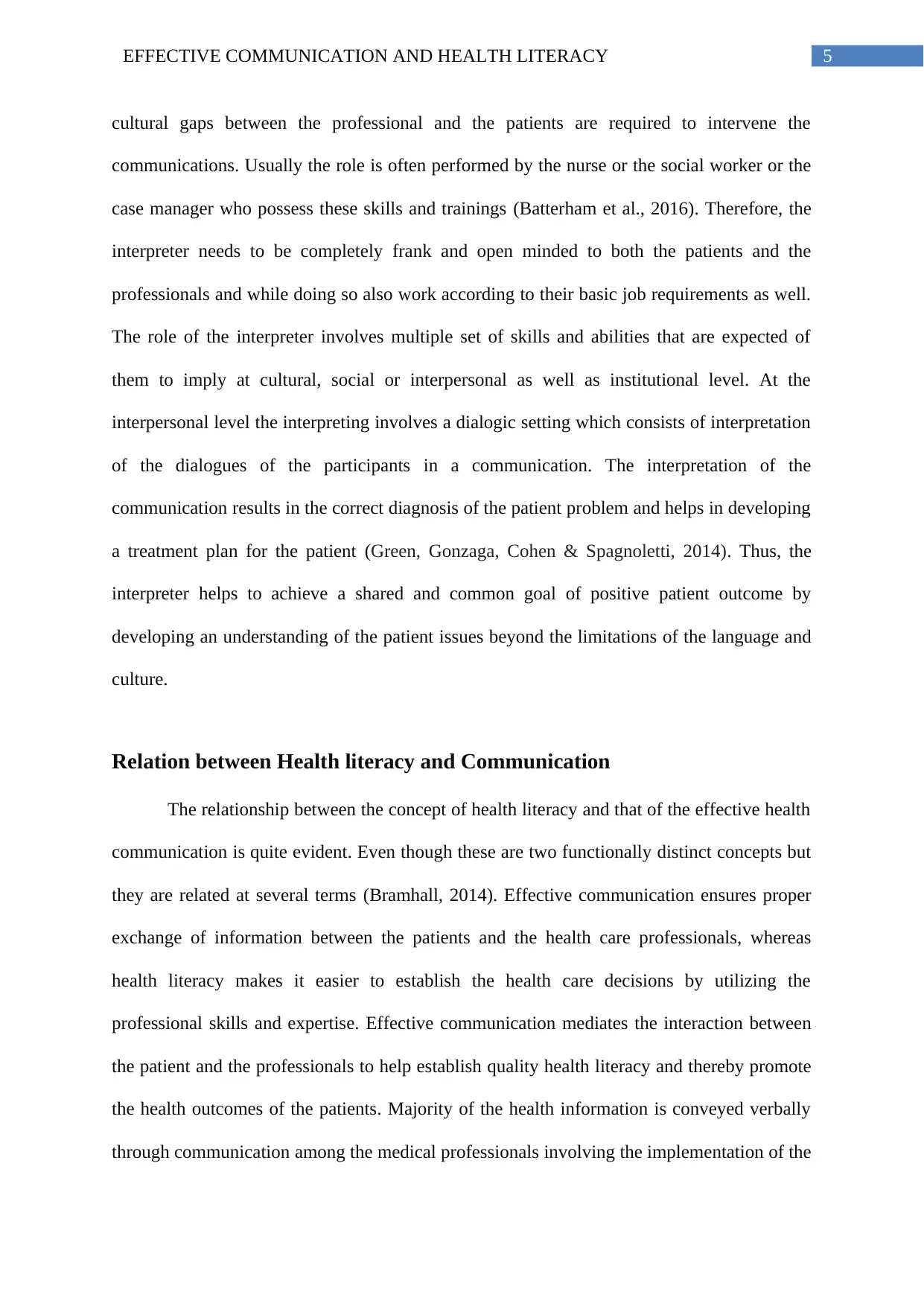
5EFFECTIVE COMMUNICATION AND HEALTH LITERACY
cultural gaps between the professional and the patients are required to intervene the
communications. Usually the role is often performed by the nurse or the social worker or the
case manager who possess these skills and trainings (Batterham et al., 2016). Therefore, the
interpreter needs to be completely frank and open minded to both the patients and the
professionals and while doing so also work according to their basic job requirements as well.
The role of the interpreter involves multiple set of skills and abilities that are expected of
them to imply at cultural, social or interpersonal as well as institutional level. At the
interpersonal level the interpreting involves a dialogic setting which consists of interpretation
of the dialogues of the participants in a communication. The interpretation of the
communication results in the correct diagnosis of the patient problem and helps in developing
a treatment plan for the patient (Green, Gonzaga, Cohen & Spagnoletti, 2014). Thus, the
interpreter helps to achieve a shared and common goal of positive patient outcome by
developing an understanding of the patient issues beyond the limitations of the language and
culture.
Relation between Health literacy and Communication
The relationship between the concept of health literacy and that of the effective health
communication is quite evident. Even though these are two functionally distinct concepts but
they are related at several terms (Bramhall, 2014). Effective communication ensures proper
exchange of information between the patients and the health care professionals, whereas
health literacy makes it easier to establish the health care decisions by utilizing the
professional skills and expertise. Effective communication mediates the interaction between
the patient and the professionals to help establish quality health literacy and thereby promote
the health outcomes of the patients. Majority of the health information is conveyed verbally
through communication among the medical professionals involving the implementation of the
cultural gaps between the professional and the patients are required to intervene the
communications. Usually the role is often performed by the nurse or the social worker or the
case manager who possess these skills and trainings (Batterham et al., 2016). Therefore, the
interpreter needs to be completely frank and open minded to both the patients and the
professionals and while doing so also work according to their basic job requirements as well.
The role of the interpreter involves multiple set of skills and abilities that are expected of
them to imply at cultural, social or interpersonal as well as institutional level. At the
interpersonal level the interpreting involves a dialogic setting which consists of interpretation
of the dialogues of the participants in a communication. The interpretation of the
communication results in the correct diagnosis of the patient problem and helps in developing
a treatment plan for the patient (Green, Gonzaga, Cohen & Spagnoletti, 2014). Thus, the
interpreter helps to achieve a shared and common goal of positive patient outcome by
developing an understanding of the patient issues beyond the limitations of the language and
culture.
Relation between Health literacy and Communication
The relationship between the concept of health literacy and that of the effective health
communication is quite evident. Even though these are two functionally distinct concepts but
they are related at several terms (Bramhall, 2014). Effective communication ensures proper
exchange of information between the patients and the health care professionals, whereas
health literacy makes it easier to establish the health care decisions by utilizing the
professional skills and expertise. Effective communication mediates the interaction between
the patient and the professionals to help establish quality health literacy and thereby promote
the health outcomes of the patients. Majority of the health information is conveyed verbally
through communication among the medical professionals involving the implementation of the
⊘ This is a preview!⊘
Do you want full access?
Subscribe today to unlock all pages.

Trusted by 1+ million students worldwide
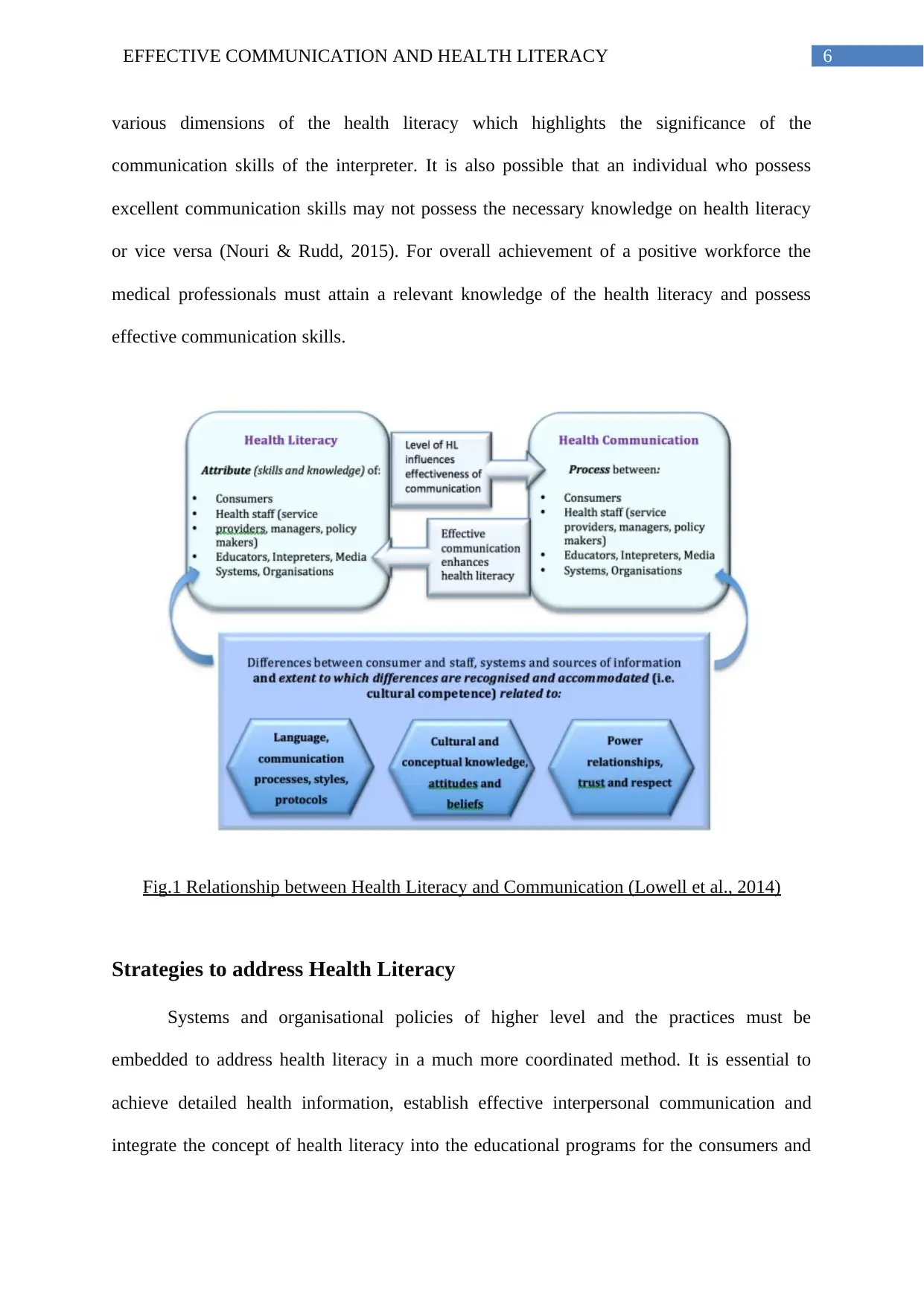
6EFFECTIVE COMMUNICATION AND HEALTH LITERACY
various dimensions of the health literacy which highlights the significance of the
communication skills of the interpreter. It is also possible that an individual who possess
excellent communication skills may not possess the necessary knowledge on health literacy
or vice versa (Nouri & Rudd, 2015). For overall achievement of a positive workforce the
medical professionals must attain a relevant knowledge of the health literacy and possess
effective communication skills.
Fig.1 Relationship between Health Literacy and Communication (Lowell et al., 2014)
Strategies to address Health Literacy
Systems and organisational policies of higher level and the practices must be
embedded to address health literacy in a much more coordinated method. It is essential to
achieve detailed health information, establish effective interpersonal communication and
integrate the concept of health literacy into the educational programs for the consumers and
various dimensions of the health literacy which highlights the significance of the
communication skills of the interpreter. It is also possible that an individual who possess
excellent communication skills may not possess the necessary knowledge on health literacy
or vice versa (Nouri & Rudd, 2015). For overall achievement of a positive workforce the
medical professionals must attain a relevant knowledge of the health literacy and possess
effective communication skills.
Fig.1 Relationship between Health Literacy and Communication (Lowell et al., 2014)
Strategies to address Health Literacy
Systems and organisational policies of higher level and the practices must be
embedded to address health literacy in a much more coordinated method. It is essential to
achieve detailed health information, establish effective interpersonal communication and
integrate the concept of health literacy into the educational programs for the consumers and
Paraphrase This Document
Need a fresh take? Get an instant paraphrase of this document with our AI Paraphraser
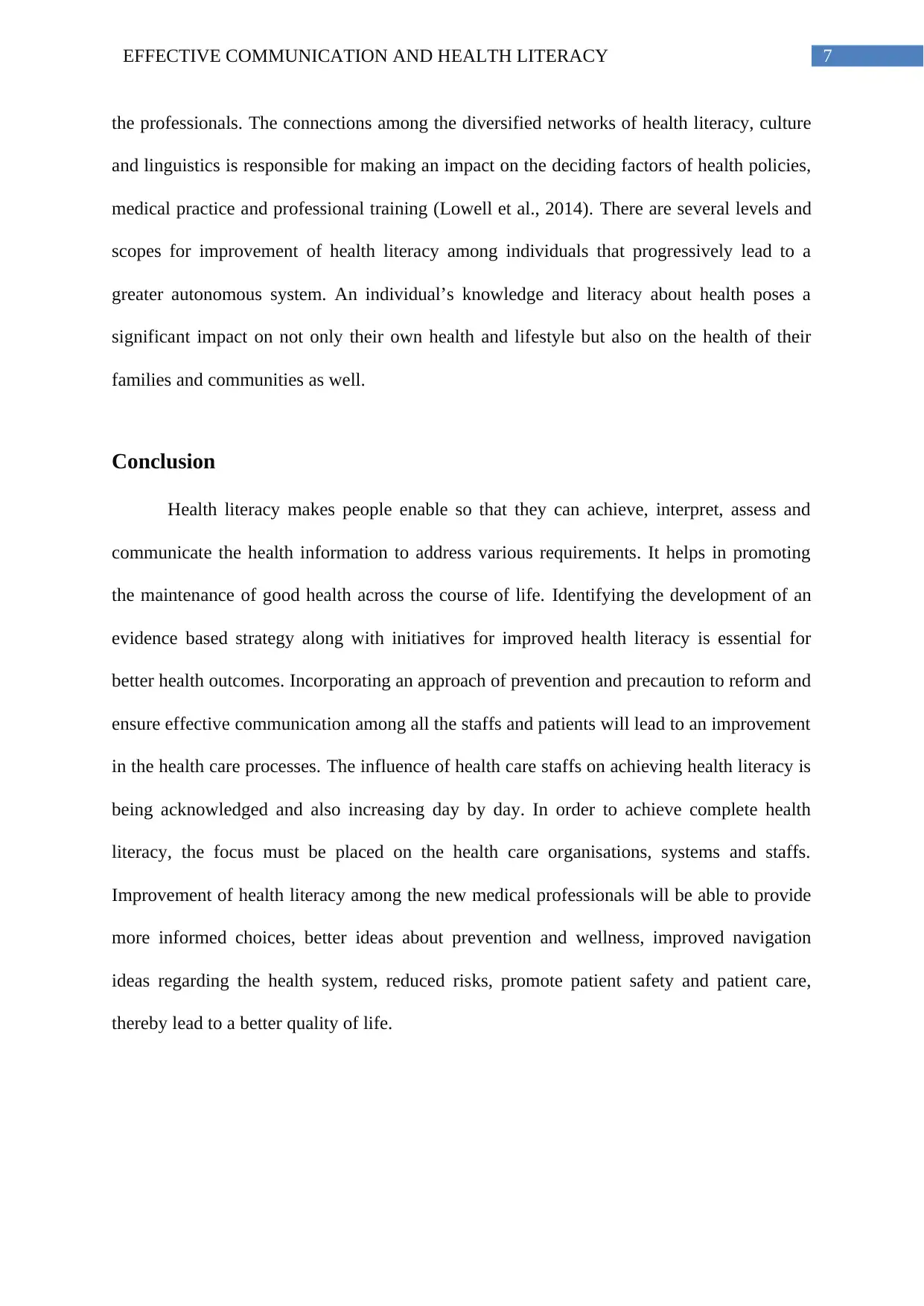
7EFFECTIVE COMMUNICATION AND HEALTH LITERACY
the professionals. The connections among the diversified networks of health literacy, culture
and linguistics is responsible for making an impact on the deciding factors of health policies,
medical practice and professional training (Lowell et al., 2014). There are several levels and
scopes for improvement of health literacy among individuals that progressively lead to a
greater autonomous system. An individual’s knowledge and literacy about health poses a
significant impact on not only their own health and lifestyle but also on the health of their
families and communities as well.
Conclusion
Health literacy makes people enable so that they can achieve, interpret, assess and
communicate the health information to address various requirements. It helps in promoting
the maintenance of good health across the course of life. Identifying the development of an
evidence based strategy along with initiatives for improved health literacy is essential for
better health outcomes. Incorporating an approach of prevention and precaution to reform and
ensure effective communication among all the staffs and patients will lead to an improvement
in the health care processes. The influence of health care staffs on achieving health literacy is
being acknowledged and also increasing day by day. In order to achieve complete health
literacy, the focus must be placed on the health care organisations, systems and staffs.
Improvement of health literacy among the new medical professionals will be able to provide
more informed choices, better ideas about prevention and wellness, improved navigation
ideas regarding the health system, reduced risks, promote patient safety and patient care,
thereby lead to a better quality of life.
the professionals. The connections among the diversified networks of health literacy, culture
and linguistics is responsible for making an impact on the deciding factors of health policies,
medical practice and professional training (Lowell et al., 2014). There are several levels and
scopes for improvement of health literacy among individuals that progressively lead to a
greater autonomous system. An individual’s knowledge and literacy about health poses a
significant impact on not only their own health and lifestyle but also on the health of their
families and communities as well.
Conclusion
Health literacy makes people enable so that they can achieve, interpret, assess and
communicate the health information to address various requirements. It helps in promoting
the maintenance of good health across the course of life. Identifying the development of an
evidence based strategy along with initiatives for improved health literacy is essential for
better health outcomes. Incorporating an approach of prevention and precaution to reform and
ensure effective communication among all the staffs and patients will lead to an improvement
in the health care processes. The influence of health care staffs on achieving health literacy is
being acknowledged and also increasing day by day. In order to achieve complete health
literacy, the focus must be placed on the health care organisations, systems and staffs.
Improvement of health literacy among the new medical professionals will be able to provide
more informed choices, better ideas about prevention and wellness, improved navigation
ideas regarding the health system, reduced risks, promote patient safety and patient care,
thereby lead to a better quality of life.
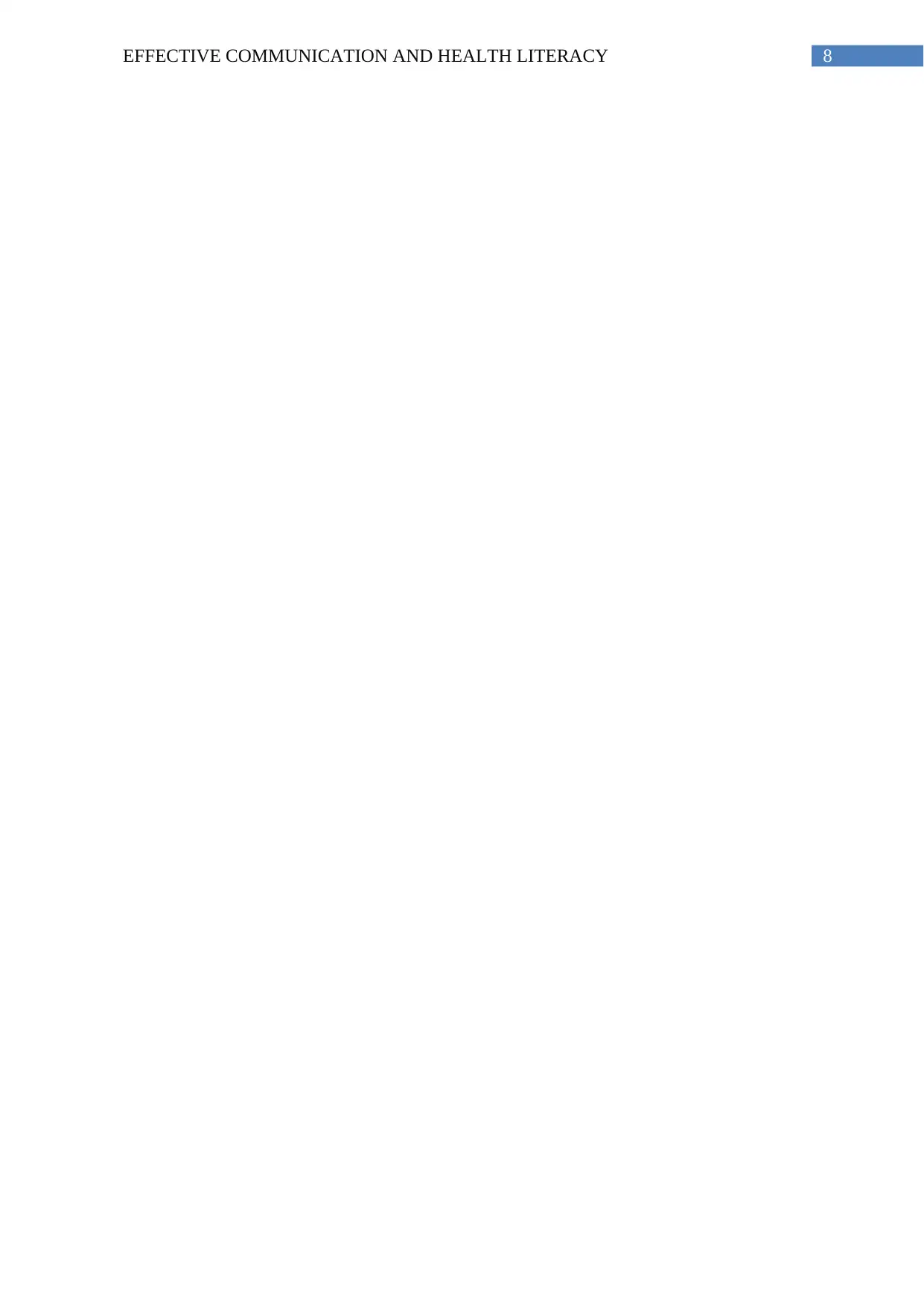
8EFFECTIVE COMMUNICATION AND HEALTH LITERACY
⊘ This is a preview!⊘
Do you want full access?
Subscribe today to unlock all pages.

Trusted by 1+ million students worldwide
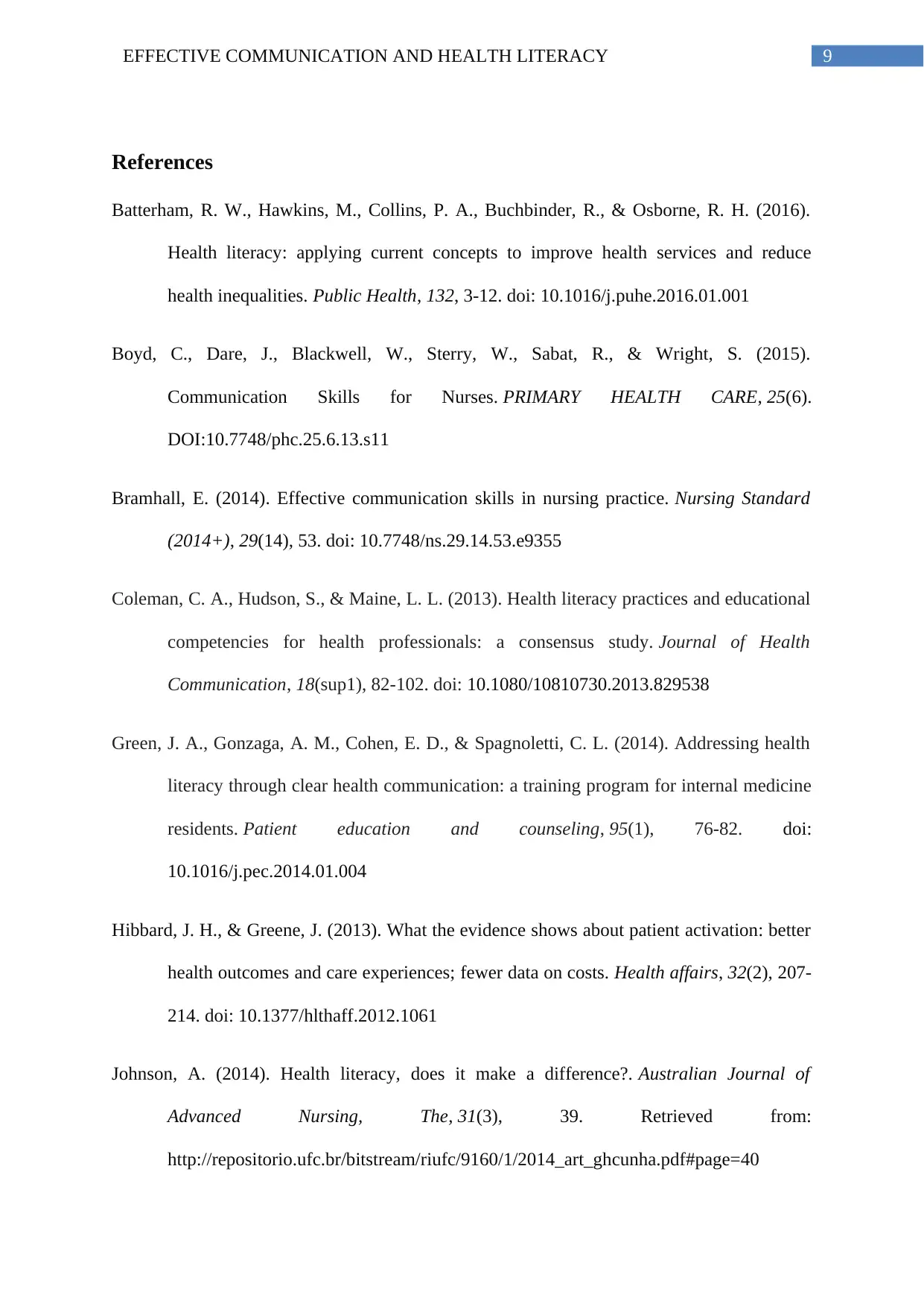
9EFFECTIVE COMMUNICATION AND HEALTH LITERACY
References
Batterham, R. W., Hawkins, M., Collins, P. A., Buchbinder, R., & Osborne, R. H. (2016).
Health literacy: applying current concepts to improve health services and reduce
health inequalities. Public Health, 132, 3-12. doi: 10.1016/j.puhe.2016.01.001
Boyd, C., Dare, J., Blackwell, W., Sterry, W., Sabat, R., & Wright, S. (2015).
Communication Skills for Nurses. PRIMARY HEALTH CARE, 25(6).
DOI:10.7748/phc.25.6.13.s11
Bramhall, E. (2014). Effective communication skills in nursing practice. Nursing Standard
(2014+), 29(14), 53. doi: 10.7748/ns.29.14.53.e9355
Coleman, C. A., Hudson, S., & Maine, L. L. (2013). Health literacy practices and educational
competencies for health professionals: a consensus study. Journal of Health
Communication, 18(sup1), 82-102. doi: 10.1080/10810730.2013.829538
Green, J. A., Gonzaga, A. M., Cohen, E. D., & Spagnoletti, C. L. (2014). Addressing health
literacy through clear health communication: a training program for internal medicine
residents. Patient education and counseling, 95(1), 76-82. doi:
10.1016/j.pec.2014.01.004
Hibbard, J. H., & Greene, J. (2013). What the evidence shows about patient activation: better
health outcomes and care experiences; fewer data on costs. Health affairs, 32(2), 207-
214. doi: 10.1377/hlthaff.2012.1061
Johnson, A. (2014). Health literacy, does it make a difference?. Australian Journal of
Advanced Nursing, The, 31(3), 39. Retrieved from:
http://repositorio.ufc.br/bitstream/riufc/9160/1/2014_art_ghcunha.pdf#page=40
References
Batterham, R. W., Hawkins, M., Collins, P. A., Buchbinder, R., & Osborne, R. H. (2016).
Health literacy: applying current concepts to improve health services and reduce
health inequalities. Public Health, 132, 3-12. doi: 10.1016/j.puhe.2016.01.001
Boyd, C., Dare, J., Blackwell, W., Sterry, W., Sabat, R., & Wright, S. (2015).
Communication Skills for Nurses. PRIMARY HEALTH CARE, 25(6).
DOI:10.7748/phc.25.6.13.s11
Bramhall, E. (2014). Effective communication skills in nursing practice. Nursing Standard
(2014+), 29(14), 53. doi: 10.7748/ns.29.14.53.e9355
Coleman, C. A., Hudson, S., & Maine, L. L. (2013). Health literacy practices and educational
competencies for health professionals: a consensus study. Journal of Health
Communication, 18(sup1), 82-102. doi: 10.1080/10810730.2013.829538
Green, J. A., Gonzaga, A. M., Cohen, E. D., & Spagnoletti, C. L. (2014). Addressing health
literacy through clear health communication: a training program for internal medicine
residents. Patient education and counseling, 95(1), 76-82. doi:
10.1016/j.pec.2014.01.004
Hibbard, J. H., & Greene, J. (2013). What the evidence shows about patient activation: better
health outcomes and care experiences; fewer data on costs. Health affairs, 32(2), 207-
214. doi: 10.1377/hlthaff.2012.1061
Johnson, A. (2014). Health literacy, does it make a difference?. Australian Journal of
Advanced Nursing, The, 31(3), 39. Retrieved from:
http://repositorio.ufc.br/bitstream/riufc/9160/1/2014_art_ghcunha.pdf#page=40
Paraphrase This Document
Need a fresh take? Get an instant paraphrase of this document with our AI Paraphraser
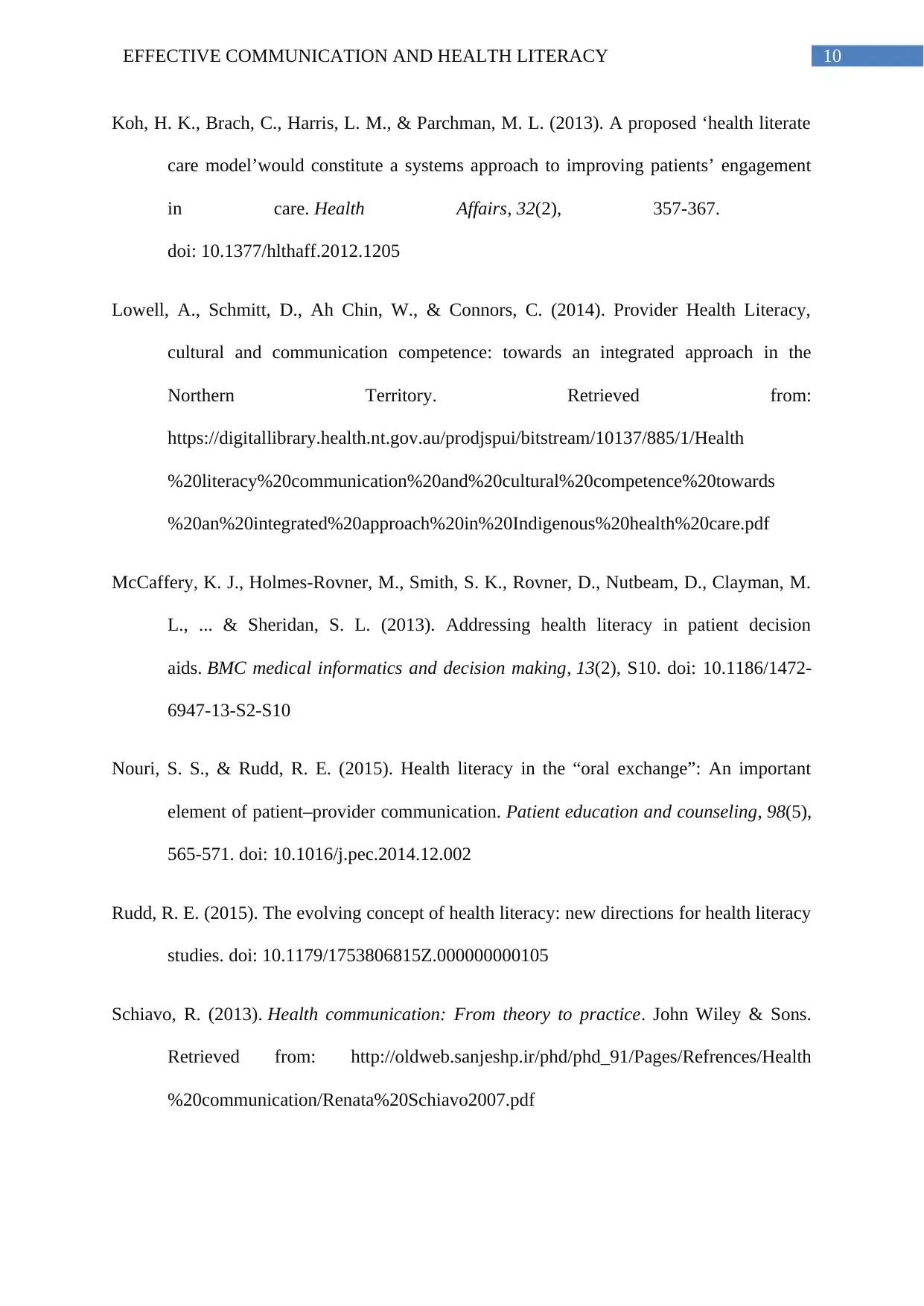
10EFFECTIVE COMMUNICATION AND HEALTH LITERACY
Koh, H. K., Brach, C., Harris, L. M., & Parchman, M. L. (2013). A proposed ‘health literate
care model’would constitute a systems approach to improving patients’ engagement
in care. Health Affairs, 32(2), 357-367.
doi: 10.1377/hlthaff.2012.1205
Lowell, A., Schmitt, D., Ah Chin, W., & Connors, C. (2014). Provider Health Literacy,
cultural and communication competence: towards an integrated approach in the
Northern Territory. Retrieved from:
https://digitallibrary.health.nt.gov.au/prodjspui/bitstream/10137/885/1/Health
%20literacy%20communication%20and%20cultural%20competence%20towards
%20an%20integrated%20approach%20in%20Indigenous%20health%20care.pdf
McCaffery, K. J., Holmes-Rovner, M., Smith, S. K., Rovner, D., Nutbeam, D., Clayman, M.
L., ... & Sheridan, S. L. (2013). Addressing health literacy in patient decision
aids. BMC medical informatics and decision making, 13(2), S10. doi: 10.1186/1472-
6947-13-S2-S10
Nouri, S. S., & Rudd, R. E. (2015). Health literacy in the “oral exchange”: An important
element of patient–provider communication. Patient education and counseling, 98(5),
565-571. doi: 10.1016/j.pec.2014.12.002
Rudd, R. E. (2015). The evolving concept of health literacy: new directions for health literacy
studies. doi: 10.1179/1753806815Z.000000000105
Schiavo, R. (2013). Health communication: From theory to practice. John Wiley & Sons.
Retrieved from: http://oldweb.sanjeshp.ir/phd/phd_91/Pages/Refrences/Health
%20communication/Renata%20Schiavo2007.pdf
Koh, H. K., Brach, C., Harris, L. M., & Parchman, M. L. (2013). A proposed ‘health literate
care model’would constitute a systems approach to improving patients’ engagement
in care. Health Affairs, 32(2), 357-367.
doi: 10.1377/hlthaff.2012.1205
Lowell, A., Schmitt, D., Ah Chin, W., & Connors, C. (2014). Provider Health Literacy,
cultural and communication competence: towards an integrated approach in the
Northern Territory. Retrieved from:
https://digitallibrary.health.nt.gov.au/prodjspui/bitstream/10137/885/1/Health
%20literacy%20communication%20and%20cultural%20competence%20towards
%20an%20integrated%20approach%20in%20Indigenous%20health%20care.pdf
McCaffery, K. J., Holmes-Rovner, M., Smith, S. K., Rovner, D., Nutbeam, D., Clayman, M.
L., ... & Sheridan, S. L. (2013). Addressing health literacy in patient decision
aids. BMC medical informatics and decision making, 13(2), S10. doi: 10.1186/1472-
6947-13-S2-S10
Nouri, S. S., & Rudd, R. E. (2015). Health literacy in the “oral exchange”: An important
element of patient–provider communication. Patient education and counseling, 98(5),
565-571. doi: 10.1016/j.pec.2014.12.002
Rudd, R. E. (2015). The evolving concept of health literacy: new directions for health literacy
studies. doi: 10.1179/1753806815Z.000000000105
Schiavo, R. (2013). Health communication: From theory to practice. John Wiley & Sons.
Retrieved from: http://oldweb.sanjeshp.ir/phd/phd_91/Pages/Refrences/Health
%20communication/Renata%20Schiavo2007.pdf
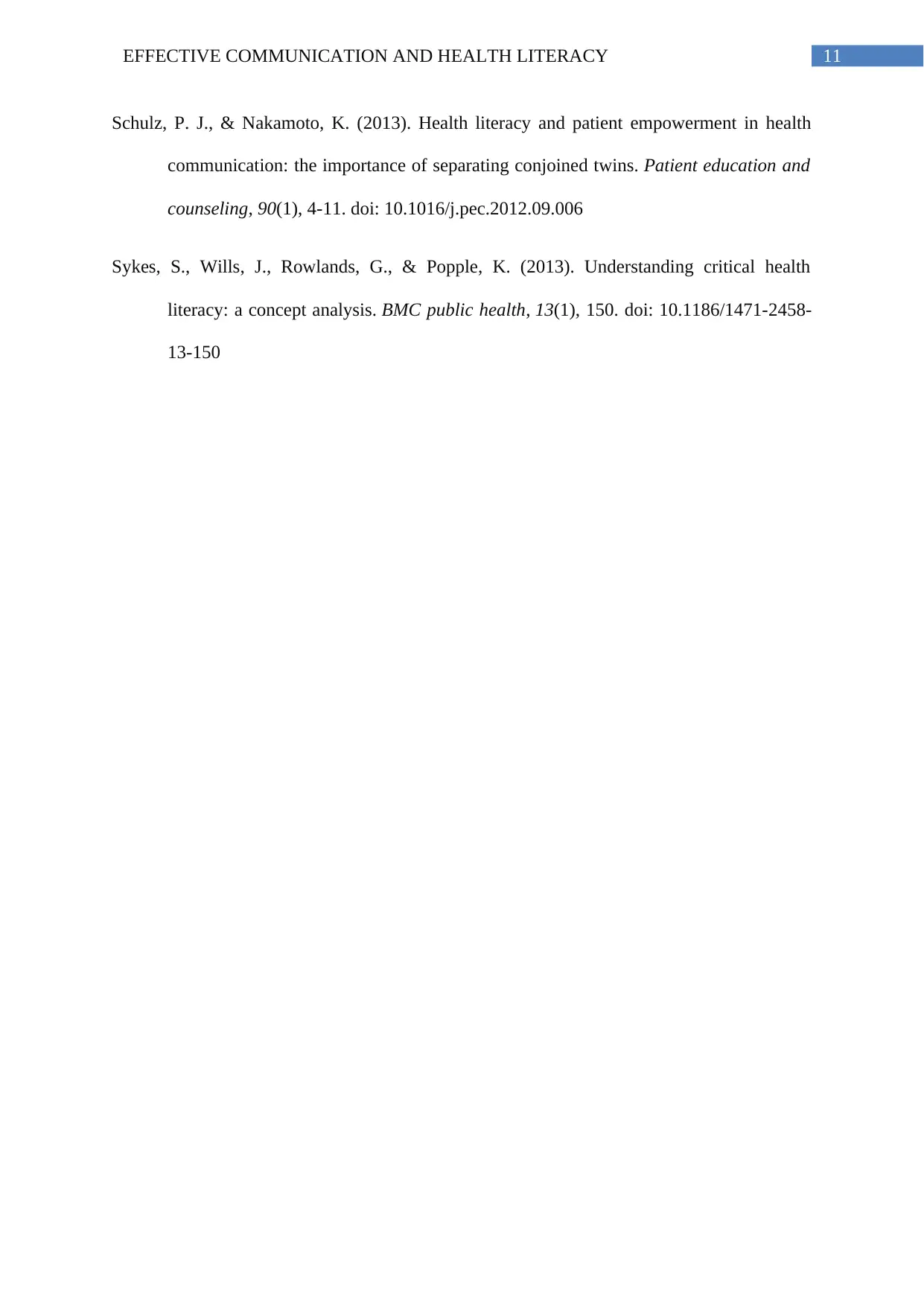
11EFFECTIVE COMMUNICATION AND HEALTH LITERACY
Schulz, P. J., & Nakamoto, K. (2013). Health literacy and patient empowerment in health
communication: the importance of separating conjoined twins. Patient education and
counseling, 90(1), 4-11. doi: 10.1016/j.pec.2012.09.006
Sykes, S., Wills, J., Rowlands, G., & Popple, K. (2013). Understanding critical health
literacy: a concept analysis. BMC public health, 13(1), 150. doi: 10.1186/1471-2458-
13-150
Schulz, P. J., & Nakamoto, K. (2013). Health literacy and patient empowerment in health
communication: the importance of separating conjoined twins. Patient education and
counseling, 90(1), 4-11. doi: 10.1016/j.pec.2012.09.006
Sykes, S., Wills, J., Rowlands, G., & Popple, K. (2013). Understanding critical health
literacy: a concept analysis. BMC public health, 13(1), 150. doi: 10.1186/1471-2458-
13-150
⊘ This is a preview!⊘
Do you want full access?
Subscribe today to unlock all pages.

Trusted by 1+ million students worldwide
1 out of 12
Related Documents
Your All-in-One AI-Powered Toolkit for Academic Success.
+13062052269
info@desklib.com
Available 24*7 on WhatsApp / Email
![[object Object]](/_next/static/media/star-bottom.7253800d.svg)
Unlock your academic potential
Copyright © 2020–2025 A2Z Services. All Rights Reserved. Developed and managed by ZUCOL.





